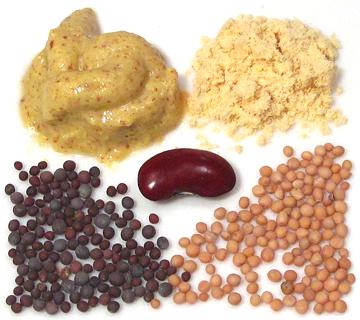
More on Spices.
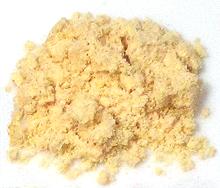
Most recipes calling for mustard powder presume using Colman's brand,
one of the earliest manufacturers (1814) of this very finely powdered
mustard, and that product (now owned by Unilever) is widely available.
Dry it is almost flavorless. For use as a condiment it is mixed with
water to make a paste and allowed to stand for 10 minutes or so until
enzymes produce the pungency. It should be mixed fresh for use as the
pungency fades fairly quickly, unless stabilized with acid.
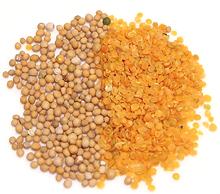
This product is hulled and split mustard seeds, sort of a mustard dal (right
in photo). It is used in some Indian spice mixes, particularly Gujarati Achar
Masala, a spice mix used in Achar pickles, and in many Achari recipes. How it
is made I am not sure, but India is expert at making hulled and split legumes.
Hulled mustard seed is much used in North America and Europe to produce
mustard powders and prepared mustards, but it is crushed between rollers and
then sifted, so it is not whole split mustard seeds like these.
Subst: Whole yellow mustard seeds. Not as strong, so use about half
again what the recipe calls for, and grind very fine.
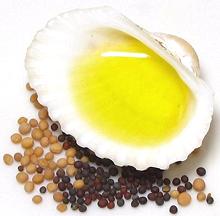 Mustard seed is also pressed for oil, and mustard oil is an important
cooking oil in parts of India, particularly in the North, and
considered essential to accurately reproduce the traditional cuisine. It
is also an important cooking oil in parts of China and Russia. Today, in
India, it has been largely replaced by industrially produced seed oils
which are much cheaper, but possibly more dangerous to health.
Mustard seed is also pressed for oil, and mustard oil is an important
cooking oil in parts of India, particularly in the North, and
considered essential to accurately reproduce the traditional cuisine. It
is also an important cooking oil in parts of China and Russia. Today, in
India, it has been largely replaced by industrially produced seed oils
which are much cheaper, but possibly more dangerous to health.
Mustard Oil can be found in markets serving an Indian community. It is always labeled "For massage use only" because it does not have FDA approval for use as food. This is due to its erucic acid content, formerly considered dangerous. It is now thought possibly dangerous in regions of extreme poverty where it is the only fat in the diet, but suspicion has lately shifted from erucic acid to excess Omega-3 oils.
Mustard oil has a somewhat acrid taste as pressed. In India, it is usually heated until the first wisp of smoke is seen, then taken off the heat to cool a little. This changes the taste, making it much more pleasant. It may also reduce the Omega-3 content, but it is still controversial if the body can really use plant Omega-3 effectively. There is also increasing suspicion that plant Omega-3s may be dangerous if too much is consumed. For more details on Mustard Oil see our Mustard Seed Oil page.
Mustard Oil is often confused with Rapeseed Oil and Canola Oil (a low
erucic acid form of rapeseed oil). This oil comes from the seeds
Brassica napus, a kind of Turnip. It's fairly closely related to
Mustards, but a different species, and the oils are not identical. For
details on rapeseed oil, see our
Canola Oil page.
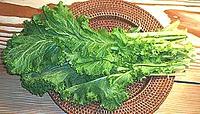 There are several kinds of Mustard Greens, Western and Asian. These are
usually from varieties of mustard developed specifically for greens, and
not the varieties grown for seeds and oil. For details see our
Cabbage, Mustard Turnip & Radish Greens
page.
There are several kinds of Mustard Greens, Western and Asian. These are
usually from varieties of mustard developed specifically for greens, and
not the varieties grown for seeds and oil. For details see our
Cabbage, Mustard Turnip & Radish Greens
page.